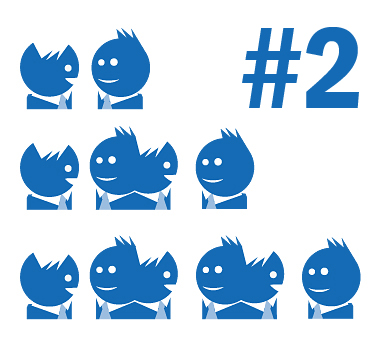The Best Process for Recruiting Channel Partners in the Software Industry
Using a channel of independent companies to resell, implement and/or service your customers has a long tradition in the history of the software industry. For some software companies the channel has been a major contributor to global success, but for most software companies making it work is a constant struggle.
The word “channel” is used in the software industry to describe independent companies that assume various roles and obligations in bringing a software product to the customers. The definition is rather broad, since the roles and obligations can vary substantially from “simple” reselling to system integration, solution development on top of the software platform, implementation in terms of consulting, project management, customization, training and support.
Proposed Process
In order to reach a leading position through channel partners, it is crucial to find, qualify, motivate, and sign partners who require a short learning curve and where time to first customer will be as short as possible. The processes described in this post are primarily related to the efforts of finding and signing up business partners.
For a description of how to identify and acquire the first customers in a new market please, download the document Market Bootstrapping Services (TBK-PFFC-001)
Preparation
The preparation phase includes preparing the concepts and documentation required for the subsequent partner search. The deliverables will also be instrumental in the process of enabling the business partner and helping him gain traction with your products and services.
The preparation phase includes the definition and documentation of:
- The Customer Value Proposition
- The Business Partner Value Proposition
- The Value Chain P&L model
Customer Value Proposition
The Customer Value Proposition is defined and documented according to the [slider title=”NABC”] Developed by the Stanford Research Institute and documented in the book: ”Innovation – the five disciplines of creating what customers want” by Curtis Carlson & William Wilmot [/slider] approach.
For a specification of the Customer Value Proposition framework please download the document TBK-PFFC-002.
Ideal Customer Profile
Based on the Customer Value Proposition you can define the Ideal Customer Profile. The Ideal Customer Profile is contributing to the understanding of which type of business partners you must to win to ensure adequate market penetration. For a specification of the Ideal Customer Profile framework please download the document TBK-PFFC-003.
Business Partner Value Proposition
The definition and documentation of the Business Partner Value Proposition is following the same structure as above, only you are here addressing the needs of and motivators of the business partner.
The Value Chain P&L Model
The Value Chain P&L Model is a best practice model of the how the values flow in the marketing, sales and delivery process. It is used to calculate the return on the investments the Business Partner will have to perform in building sales, marketing and support capabilities for your products and services.
The Value Chain P&L Model is used in the qualification interviews with potential business partner candidates as well as in determining the go-to-market approach and in the development of the sales and marketing plan.
Ideal Partner Profile
Based on the Business Partner Value Proposition and the Value Chain P&L Model, you can define the Ideal Business Partner Profile that you will use as basis for the recruitment process.
Execution
The execution phase includes the following steps:
The Long list
Based on the Ideal Business Partner Profile you will produce a long list of candidates that you could briefly interview. You will typically identify 5-10 candidates per business partner you are to recruit.
The Short List
Based on the initial interviews, you may short list 3-5 candidates. These 3-5 candidates will be invited to an [slider title=” interview “] typically 2 hours per interview [/slider] with your executive management.
Based on these interviews you will invite 2-3 to participate to an Assessment Centre.
The Assessment Center
The objective of the Assessment Centre is to verify that the candidates understands the opportunities, challenges and requirements of the business relationship with the you, and that the candidate possesses the critical skills and resources required to successfully achieve the market position and align to general expectations for the Go-To-Market activity planning covering the first 6-12 months. The Assessment Centre also provides the candidate an opportunity for understanding your business model and for verifying his expectations and requirements for support from you.
Letter of Intent
Based on the outcome of the Assessment Centre, a Letter of Intent is signed with the partner(s) who are qualified and motivated.
Go-To-Market planning
In this phase you are defining the steps and actions required to win the first clients and ensure they become happy references.
For a specification of Market Bootstrapping services please download TBK-PFFC-001
Partner Cooperation Framework
The reseller landscape has changed dramatically over the last 15 years. The reality today is that there are more software companies looking for resellers than there are resellers looking for software.
To be successful with resellers we need to fulfil several criteria:
- The “Go-To-Market” strategy must be well defined, documented and proven.
- The sales process must be well defined, documented and proven.
- The “learning curve” must be well defined, documented and proven.
- The return on investment must be well defined, documented and proven.
- We must provide a support program, which “ensures” that the reseller will win his first two-five clients in the shortest possible time.
To accommodate these requirements a Partner Program must be available.
The TBK Partner Program consists of five deliverables:
1 |
Partner Program Guidelines | This document describes the guiding principles behind and all the elements in the Partner Program. The Guidelines are for internal learning and reference purposes. | Internal |
2 |
Partner Program | This document describes the Partner Value Proposition, the Partner P&L model and the joint activities ensuring a fast route to winning the first clients. The Partner Program also explains how the ongoing relationship is managed. | External |
3 |
Partner Agreement | This is the legal document containing the non-negotiable terms and conditions for the partnership. | External |
4 |
Partner Management Framework | The objective of Partner Management framework is to identify and support the most successful partners with increasingly professional management support. TBK Consult recommends using the ValuePartner® framework. | External |
5 |
Partner Portal | All documentation, polices & procedures and all other information should be available and all announcements should be made through a web based Partner Portal. A e-mail marketing facility should be available for pushing information to the channel. | External |
Other articles in this series:
- Successful Channel Building in The Software Industry
- What’s a best practice solution for managing channel partners in the software industry?
- Steps to designing and executing productive Partner Channel Programs in the software industry
- Partner P&L – the path to productive partners in the software industry
- Strategic Partner Development in the Software Industry










